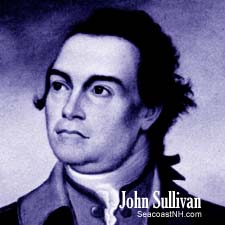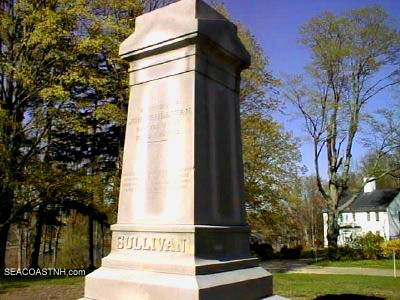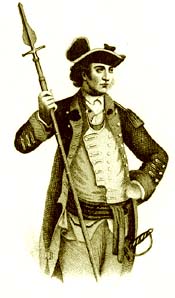| General John Sullivan |

FRAMERS OF FREEDOM
John Sullivan was one of the best known New Hampshire figures in the Revolution, but he was also one of the most controversial. Disliked by Gen. Washington, despised by citizens of his town in Durham, Sullivan became one of the first governors in New Hampshire after taking a major role in the American Revolution. Also a second essay focusing on Sullivan's role as a mason.
MORE on Sullivan's role as a Mason
READ: Sullivan defends his client John Paul Jones
John Sullivan was born in the parish of Somersworth, NH on February 17, 1740, the third son of Irish redemptioner immigrants. His father was the local schoolmaster and he made sure his son received a good education. Sullivan read the law with Samuel Livermore, and in 1764 he bought three acres on the bank of the Oyster River in Durham and hung out his shingle there, becoming the town's first lawyer.
Rich Lawyer, British Friend
Vain and ambitious, the black-haired lawyer was determined to get rich. His methods included foreclosing on debts owed him and suing his neighbors. Soon he was hated by most of Durham. More than once mobs of his victims attacked him. In June of 1766, a petition signed by 133 citizens of Durham was presented to the General Court, asking for relief from the "Oppressive Extortive Behavior of one Mr. John Sullivan." With the aid of a few favorable depositions from his friends, Sullivan talked the court into dismissing the petition and then sued unsuccessfully for libel. Whatever his ethics, the records show that between September of 1764 and May of 1772 Sullivan won 35 actions and more than 3000 pounds.
As the years passed, Sullivan increased his holdings in the Durham area and gradually improved his relations with the town's residents. In the late 1760s Sullivan supported Britain and became a favorite of Royal Governor John Wentworth. Because of his friendship with Wentworth, Sullivan was commissioned as a major in the militia. He had attained all the things he had worked for since his arrival in Durham: wealth, power, respect and leadership. Logically, John Sullivan should have been content to help maintain the status quo, but he was an ambitious man and seldom happy with what he had.

Converted To Revolution
As relations between Britain and America eroded in the early 1770s, Sullivan joined the ranks of the dissidents. On July 21, 1774, the First Provincial Congress of New Hampshire met in Exeter. Sullivan attended, representing Durham, and was elected as a delegate to the First Continental Congress. At Philadelphia, he became involved in many issues, generally aligning himself with the radicals from Massachusetts.
In November, 1774, Sullivan returned to New Hampshire and on December 15, he committed himself totally to the Revolution when he led a raid on Fort William and Mary in New Castle to secure arms for the rebel cause.
Early in 1775, Sullivan and John Langdon were elected to the Second Continental Congress. At Philadelphia, the delegates voted to take on the regulation of the army and appointed Sullivan a brigadier general.
Sullivan's military career was long and controversial. After a nine-month siege the American Army drove the British out of Boston; in the spring of '76 Washington sent Sullivan to Canada. There he took command of the sick, dispirited, and mutinous remnants of the army that had invaded Canada the previous year. Stubborn and with high hopes of military victories, Sullivan wrote Washington that he was "Determin'd to hold," but he was soon forced to retreat. Sullivan's enemies in Congress criticized him severely for the retreat, but on August 9 the delegates voted to promote him to the rank of major general. At about this time, Washington described Sullivan as "active, spirited, and Zealously attach'd to the cause" and went on to say that he had "a little tincture of vanity . . . an over desire of being popular, which now and then leads him into some embarressments."
In August of 1776, Sullivan joined Washington, who was confronting the British Gen. Howe in New York. On August 20 he received command of Long Island, but three days later Washington took part of his command away and gave it to Gen. Israel Putnam. The disaster that followed was due in part to the poor definition of the division of command. In the melee the British and Hessians attacked the Americans from both sides and routed them. Brave to the point of being fool hardy, Sullivan, with a pistol in each hand, engaged the Hessians in a running battle in a corn field and was captured.
While a prisoner of war, Sullivan served as an intermediary between Gen. Howe's brother, Adm. Richard Howe, and the Continental Congress, carrying the admiral's peace proposals. The negotiations collapsed almost immediately and Sullivan was again criticized by Congress. John Adams called him a "decoy duck whom Lord Howe had sent among us to seduce us into a renunciation of our independence."
CONTINUE to read about Major Gen. JOHN SULLIVAN
THE REVOLUTIONARY & NH GOVERNOR (continued)
At Odds with Washington
After Sullivan was released in a prisoner exchange, he rejoined Washington in New Jersey. On December 25, 1776, the American forces crossed the Delaware River and hit the Hessians in Trenton. Sullivan was in the thick of the fighting. He and his command captured a vital bridge across the Assanpink Creek and sealed the mercenaries into Trenton. Sullivan finally had his military victory, and his good luck continued through the early part of January, 1777, as his forces helped push the British out of Princeton.
 The beginning of 1777 found Sullivan in high spirits, but these did not last long. He was soon arguing with George Washington, the Continental Congress, and everybody else over commands and promotions. In response to Sullivan's requests and complaints, Washington wrote to him saying, "No other officer of rank in the whole army has so often conceived himself neglected, slighted and ill-treated as you have done, and none I am sure has had less cause than yourself to entertain such ideas."
The beginning of 1777 found Sullivan in high spirits, but these did not last long. He was soon arguing with George Washington, the Continental Congress, and everybody else over commands and promotions. In response to Sullivan's requests and complaints, Washington wrote to him saying, "No other officer of rank in the whole army has so often conceived himself neglected, slighted and ill-treated as you have done, and none I am sure has had less cause than yourself to entertain such ideas."
In August Sullivan failed in an attempt to capture Staten Island and in September he commanded the right flank at the disastrous Battle of Brandywine. A court of inquiry absolved him of any blame for the failure at Staten Island, but his enemies in Congress made him the scapegoat of Brandywine.
In October Sullivan's bad luck accompanied him to Germantown, another disaster. From there he went to an inconsequential command in Rhode Island in 1778 and on an indecisive campaign against the Iroquois of the Six Nations in New York in 1779. Sick, broke and at odds with Congress, Sullivan retired from the army in November of 1779 and returned to New Hampshire.
Governor, Judge, Drinker
Sullivan's retirement was short lived. In New Hampshire he was a hero, and the state re-elected him to the Continental Congress, where he raised his voice on such issues as New Hampshire's land claims in Vermont, Revolutionary finances and peace with Britain. In need of money, Sullivan accepted a loan of 68 guineas from the French minister at Philadelphia, the Chevalier de la Luzerne. His enemies in Congress were quickly on his back with charges that he had taken a bribe and was on the French payroll. Embarrassed once more, he left Congress for good in August of 1781.
Back in Durham, Sullivan busied himself with recouping his wasted fortune and with politics. He served as attorney general and as speaker of the house. He and John Langdon led the long legislative campaign which resulted in New Hampshire becoming the ninth state to ratify the Constitution on June 21, 1788. In 1789 he was elected to a third and last term as president and in the same year President Washington appointed him as a federal judge for the district of New Hampshire. Sullivan's appointment was something of a personal endorsement as Washington only appointed men of outstanding ability and unquestionable loyalty. Sullivan never resigned his judgeship although his health prevented him from sitting on the bench after May of 1792.
John Sullivan's last years were miserable ones. He became involved in land feuds in Durham, went into debt and grew senile. His daily drinking irritated an ulcer and he suffered from a progressive nervous disease. Only a shadow of his former self, he was forsaken by all but his family and a few friends. He died in his home on January 23, 1795, a man who found happiness only in action and peace only in death.
By Steve Adams
SOURCE: Originally published in "NH: Years of Revolution," Profiles Publications and the NH Bicentennial Commission, 1976. Reprinted by permission of the publisher and originally published here on SeacoastNH.com in 1997.
CONTINUE to read about Major Gen. JOHN SULLIVAN
Another Viewpoint:
Major Gen. John Sullivan: Honored NH Mason
By Gerald D. Foss, Grand Historian
St. John's Lodge #1,Portsmouth, NH
John Sullivan was bom in Somersworth, New Hampshire, February 17, 1740. He studied law and was admitted to practice before the courts of the Royal Province of New Hampshire. His home and place of business were in Durham, New Hampshire. Durham sent him to the Provincial Assembly early in 1774 as its representative. This led to his appointment as a delegate to the first Continental Congress. Appointed brigadier general in the Continental Army in 1775, he was promoted to major general in 1776. After being engaged in several prominent battles of that war he resigned his commission late in 1779.
He was sent to the Continental Congress again in 1780 and 1781. Attomey-general of New Hampshire from 1782 to 1786, he was chosen President (Governor) of New Hampshire in 1786 and 1787. He was Speaker of the House in 1788 and also president of the Constitutional Convention which ratified the Federal Constitution. This made New Hampshire the state to establish the United States of America. He was chosen presidential elector for 1789 and cast his vote for President George Washington. Again he was elected President (Governor) of the State of New Hampshire in 1789. President Washington appointed him as the first judge of the Federal District Court in the latter part of 1789, a position which he held at his death. Harvard College conferred upon Sullivan the degree of Master of Arts in 1780 and Dartmouth College be- stowed the degree of Doctor of Laws on him in 1789.
Many honors have been accorded General John Sullivan. Among them are the incorporation of the Town of Sullivan in Cheshire County, New Hampshire, in 1787; establishment in 1827 of the County of Sullivan, New Hampshire; erection of a granite monurnent by the State of New Hampshire in 1894 near his home in Durham, New Hampshire. More recently, a steel span across the Piscataqua River from Newington to Dover Point was named in his honor. In 1929, the United States Post Of- fice issued a commemorative postage stamp bearing his likeness in honor of his victorious New York expedition against the Indians. The State of New York honored him in 1879 by erecting a monument at Ithaca. The Town of Epping, New Hampshire, which long had a Masonic lodge called Sullivan Lodge No. 19, renamed it Major General John Sullivan Lodge No. 2., F. & A.M., a few years ago.
Sullivan's Masonic career commenced in old St. John's Lodge Portsmouth, NH on March 19, 1767. That evening the lodge held a regular communication in the house of Isaac Williams of Portsmouth. The minutes of that meeting, in part: "This evening proposed by Br. Hall Jackson, Mr. John Sullivan, who was balloted for, and unanimously agreed to be made this evening and acquainted him the result of the Lodge, he was ready and according was made a Mason this evening." It would be twenty-two years before the Grand Lodge of New Hampshire would be established, but of the first officers chosen in 1789, four were present March 19, 1767. John Sullivan, Hall Jackson, George Turner and Joseph Bass. John Sullivan received the degree of Master Mason December 28, 1768,in the Master's Lodge at Portsmouth.
On this date the lodge room was located in the new Earl of Halifax Tavern, owned and operated by Brother John Stavers. Although the name of the tavern had been changed to Pitt Tavern during the Revolutionary War, it was in the same building that deputies from Masonic lodges met July 8, 1789 to organize the Grand Lodge of New Hampshire. From 1768 to 1774 the minutes record the occasional presence of John Sullivan, but since his home was about twelve miles from the lodge room it is to be expected his attendance was not as regular as of those living in close proximity to it. On November 22, 1775 the St. John's Lodge minutes record that Major Joseph Cilley was made a Mason gratis "for his Good Services in Defense of his Country." Brigadier General John Sullivan was present this evening.
This date was during the period in which General George Washington had ordered Brigadier General Sullivan to Portsmouth to check harbor defenses. The records show that Major General John Sullivan on the evening of March 27, 1777, proposed that Major Winborn Adams be made a Mason. It was done. Unfortunately, Lt. Col. Adams was killed less than six months later leading his regiment into battle at Bemis Heights. While General Sullivan was in charge of the campaign to secure Rhode Island he visited the Providence Lodge of Freemasons frequently. When he was ordered to depart from Rhode Island, the Providence Lodge voted that a committee present an address "to our worthy Brother Major-General John Sullivan, in behalf of this lodge . . . ." It was published in the Providence Gazette of March 27, 1779. The message extends "most cordial Thanks, for the particular Honor you have done them, in so frequently associating with them in Lodge;". It is a touching tribute. General Sullivan's reply to the address is also interesting for it shows clearly his knowledge and approbation of Masonry. In 1788 St. John's Lodge adopted its fourth set of bylaws. At the end of the bylaws, as was the custom, each member signed his name. The well-known signature of "jno Sullivan" appears, in his own handwriting, to this set of laws.
In the spring of 1789 several New Hampshire Masons were promoting the establishment of its own Grand Lodge. The first meeting was held in the Pitt Tavem July 8, 1789. Sullivan, then President of New Hampshire, was elected the first Grand Master. He was absent, but at the second meeting, held July 16, 1789, he was present to accept the office. Because he had not served as a Worshipful Master of a symbolic lodge, there was a delay in his installation as Grand Master. It was arranged for him to be elected Worshipful Master of St. John's Lodge at its next annual meeting.
On December 3, 1789 , St. John's Lodge held its annual meeting and elected Sullivan Worshipful Master for the ensuing year. He was duly installed as Master of his lodge December 28, 1789, and conducted his first meeting January 4, 1790. On April 8, 1790, plans were completed for the elaborate installation ceremonies of the Grand Lodge officers for the first time in New Hampshire. The event was held in the Assembly Hall on Vaughan Street because the crowd was too large for the lodge room. Brother and Doctor Hall Jackson, the oldest Master in the chair, installed John Sullivan into the office of Most Worshipful Grand Master of the Grand Lodge of Free and Accepted Masons in and for the State of New Hampshire. Grand Master Sullivan then proceeded to appoint and install the other officers who would serve with him during the ensuing year.
The regular quarterly communication of the Grand Lodge was held April 28, 1790, at which time Most Worshipful John Sullivan presided. Six months later he declined to serve further because of ill health. On October 27, 1790, Dr. Hall Jackson, his proponent of 1767, was elected to succeed Sullivan as Grand Master. After a long illness, Sullivan died at his home in Durham January 23, 1795 and was buried in the family cemetery situated in back of his home. In this burial ground, in addition to a suitable gravestone, is a large stone on which is mounted a bronze marker. The latter was placed there by the Grand Lodge of New Hampshire in 1964, that the spot might be found if occasion should require it.
SOURCE: Excerpted with permission from "Three Centuries of Freemasonry in New Hampshire" by Gerald Foss, NH Publishing, Somersworth, 1972. Electronic use copyright © 2005 SeacoastNH.com. For more information: St. John's Lodge #1
